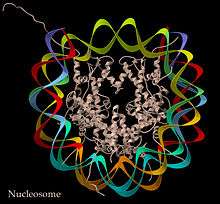Nucleoprotein
Nucleoproteins are any proteins that are structurally associated with nucleic acids,[1] either DNA or RNA. Typical nucleoproteines include ribosomes, nucleosomes, and all viruses.
Examples
Deoxyribonucleoproteins

A deoxyribonucleoprotein (DNP) is a complex of DNA and protein. The prototypical examples are nucleosomes, complexes in which genomic DNA is wrapped around clusters of eight histone proteins in eukaryotic cell nuclei to form chromatin. Protamines replace histones during spermatogenesis.
Ribonucleoproteins
A ribonucleoprotein (RNP) is a complex of RNA and protein. The enzyme telomerase, vault ribonucleoproteins, RNase P, hnRNP and small nuclear RNPs (snRNPs), and ribosomes are ribonucleoproteins. Ribosomes consist of one molecule of each of 50 or more ribosomal proteins along with three different molecules of RNA in prokaryotes or four in eukaryotes.
Some viruses are simple ribonucleoproteins, containing only one molecule of RNA and a number of identical protein molecules. Others are ribonucleoprotein or deoxyribonucleoprotein complexes containing a number of different proteins, and exceptionally more nucleic acid molecules.
Functions
In eukaryotic cells, DNA is associated with about an equal mass of histone proteins in a highly condensed nucleoprotein complex called chromatin.[2] Deoxyribonucleoproteins in this kind of complex interact to generate a multiprotein regulatory complex in which the intervening DNA is looped or wound. The deoxyribonucleoproteins participate in regulating DNA replication and transcription.[3]
The ribonucleoproteins play a role of protection. mRNAs never occur as free RNA molecules in the cell. They always associate with ribonucleoproteins and function as ribonucleoprotein complexes.[2]
In the same way, the genomes of negative-strand RNA viruses never exist as free RNA molecule. The ribonucleoproteins protect their genomes from RNase.[4] Nucleoproteins are often the major antigens for viruses because they have strain-specific and group-specific antigenic determinants.
Structure

Through crystallographic methods, the specific spatial structure and biological functions of many nucleoproteins are understood.[5][6] The structures of many viral nucleoproteins have been determined, including those of influenza virus,[7] rabies virus, ebola and lassa. Important techniques for detecting the structures of nucleoproteins include X-ray diffraction, nuclear magnetic resonance and cryo-electron microscopy.
References
- ↑ Nucleoproteins at the US National Library of Medicine Medical Subject Headings (MeSH)
- 1 2 Lodish, Harvey. Molecular Cell Biology.
- ↑ Echols, Harrison (1990). "Nucleoprotein structures initiating DNA replication, transcription, and site-specific recombination". The Journal of Biological Chemistry. PMID 2203758.
- ↑ Ruigrok, Rob WH; Crépin, Thibaut; Kolakofsky, Dan. "Nucleoproteins and nucleocapsids of negative-strand RNA viruses". Current Opinion in Microbiology. 14 (4): 504–510. doi:10.1016/j.mib.2011.07.011.
- ↑ Graeme K. Hunter G. K. (2000): Vital Forces. The discovery of the molecular basis of life. Academic Press, London 2000, ISBN 0-12-361811-8.
- ↑ Nelson D. L., Cox M. M. (2013): Lehninger Biochemie. Springer, ISBN 978-3-540-68637-8.
- ↑ Ng, Andy Ka-Leung; Wang, Jia-Huai; Shaw, Pang-Chui (2009-05-27). "Structure and sequence analysis of influenza A virus nucleoprotein". Science in China Series C: Life Sciences. 52 (5): 439–449. doi:10.1007/s11427-009-0064-x. ISSN 1006-9305.